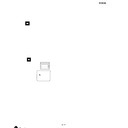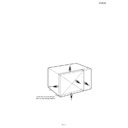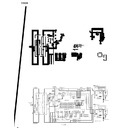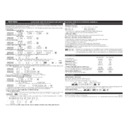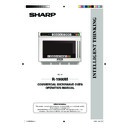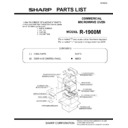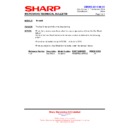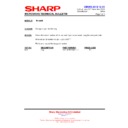Sharp R-1900M (serv.man7) Service Manual ▷ View online
R1900M
6 – 5
3. CARRY OUT 4R CHECKS.
CAUTION: IF THE TEMPERATURE FUSE INDICATES AN OPEN CIRCUIT AT ROOM TEMPERATURE, REPLACE TEMPERATURE FUSE.
[12] L: MAGNETRON THERMISTOR TEST
1. CARRY OUT 3D CHECKS.
2. Disconnect the connector of the magnetron thermistor from the harness. Measure the resistance of the thermistor with an ohmmeter. Connect the
ohmmeter leads to the connector of the thermistor.
If the meter does not indicate above resistance, replace the thermistor.
3. CARRY OUT 4R CHECKS.
[13] M: EXHAUST THERMISTOR TEST
The exhaust thermistor can be checked by using the Special function (SF-6). Check the exhaust thermistor, referring to the pages of the Exhaust ther-
mistor check (SF-6).
mistor check (SF-6).
If the display shows “OH”, the exhaust thermistor is normal. If the display shows “no”, the exhaust thermistor is abnormal and it should be replaced.
[14] N: NOISE FILTER TEST
1. CARRY OUT 3D CHECKS.
2. Disconnect the lead wires from the terminal the noise filter. Using an ohmmeter, check
between the terminals as described in the following table. If incorrect reading are obtained,
replace the noise filter.
replace the noise filter.
3. CARRY OUT 4R CHECKS.
[15] O: KEY UNIT TEST
1. CARRY OUT 3D CHECKS.
2. Check Key unit ribbon connection before replacement.
3. If key unit ribbon connection is normal, carry out the following procedures.
4. Re-install the rear cover and the outer case (cabinet).
5. Reconnect the power supply cord.
6. The following symptoms indicate a defective key unit.
1) When touching the pads, a certain pad produces no signal at all.
2) When touching a number pad, two figures or more are displayed.
3) When touching the pads, sometimes a pad produces no signal.
7. When you can not judge if the key unit is normal or not by using the item 8 above, carry out following test procedures.
1) Disconnect the power supply cord, and then remove outer case and rear cover.
2) Open the door and block it open.
3) Discharge two high voltage capacitors.
4) Disconnect the leads to the primary of the power transformer.
5) Ensure that these leads remain isolated from other components and oven chassis by using
insulation tape.
6) Reconnect the power supply cord.
Room temperature
Resistance
20
°C
Approx. 750K
Ω
MEASURING POINT
INDICATION OF OHMMETER
Between source terminals
Approx. 470K
Ω
Between source (Black) and load (Black) terminals
Short circuit.
Between source (White) and load (White/Brown) terminals
Short circuit.
WEAK
POINT
NOISE FILTER
NOISE SUPPRESSION COIL
LINE CROSS CAPACITOR
1.0μF / AC 275V
DISCHARGE RESISTOR
470K 1/2W
LINE BYPASS
CAPACITOR
0.0033μF / AC 250V
LINE BYPASS
CAPACITOR
0.0033μF / AC 250V
Load
(Black)
Load
(Gray/White)
Source
(Blue)
Source
(Brown)
5
4
3
2
7
8
9
6
1
2
3
4
3
4
1
5
6
7
2
3
4
3
4
1
5
6
7
2
3
4
3
4
1
5
6
7
8
8
STOP
CLEAR
1
START
3
4
9
5
6
0
7
8
STOP
CLEAR
1
2
X2/X3
START
3
4
9
5
6
0
7
8
CN-M
CN-R
CN-Z
2
CUSTOM
SETTING
SET
MEMORY
EXPRESS
DEFROST
MANUAL
REHEAT
POWER
LEVEL
CN-Q
< DOOR KEY UNIT >
< KEY UNIT >
< SW UNIT >
R1900M
6 – 6
7) If the display fails to clear when the STOP/CLEAR pad is depressed, first verify the flat ribbon cable is making good contact, verify that the door
sensing switch (stop switch) operates properly; that is the contacts are closed when the door is closed and open when the door is open. If the
door sensing switch (stop switch) is good, disconnect the flat ribbon cable that connects the key unit to the control unit and make sure the door
sensing switch is closed (either close the door or short the door sensing switch connector). Use the Key unit matrix indicated on the control
panel schematic and place a jumper wire between the pins that correspond to the STOP/CLEAR pad making momentary contact. If the control
unit responds by clearing with a beep the key unit is faulty and must be replaced. If the control unit does not respond, it is faulty and must be
replaced. If a specific pad does not respond, the above method may be used (after clearing the control unit) to determine if the control unit or
key pad is at fault.
door sensing switch (stop switch) is good, disconnect the flat ribbon cable that connects the key unit to the control unit and make sure the door
sensing switch is closed (either close the door or short the door sensing switch connector). Use the Key unit matrix indicated on the control
panel schematic and place a jumper wire between the pins that correspond to the STOP/CLEAR pad making momentary contact. If the control
unit responds by clearing with a beep the key unit is faulty and must be replaced. If the control unit does not respond, it is faulty and must be
replaced. If a specific pad does not respond, the above method may be used (after clearing the control unit) to determine if the control unit or
key pad is at fault.
8) For the door key unit, check the open/short and/or connection of the switch unit and the harness, too.
8. If the Key unit is defective.
1) Disconnect the power supply cord, and then remove outer case and rear cover.
2) Open the door and block it open.
3) Discharge two high voltage capacitors.
4) Replace the Key unit.
5) Reconnect all leads removed from components during testing.
6) Re-install the rear cover and the outer case (cabinet).
7) Reconnect the power supply cord after the rear cover and the outer case are installed.
8) Run the oven and check all functions.
[16] P: CONTROL UNIT TEST
The following symptoms indicate a defective control unit. Before replacing the control unit, perform the Key units test (Procedure O) to determine if
control unit is faulty.
control unit is faulty.
Connect the power supply cord. And check for followings.
1. In connection with pads.
1) When touching the pads, a certain group of pads do not produce a signal.
2) When touching the pads, no pads produce a signal.
2. In connection with display
1) At a certain digit, all or some segments do not light up.
2) At a certain digit, brightness is low.
3) Only one indicator does not light.
4) The corresponding segments of all digits do not light up; or they continue to light up.
5) Wrong figure appears.
6) A certain group of indicators do not light up.
7) The figure of all digits flicker.
3. Other possible problems caused by defective control unit.
1) Buzzer does not sound or continues to sound.
2) Cooking is not possible.
4. If the protectors F1 and/or F2 on the control unit PWB are open, the control unit is defective. To check, carry out following procedures.
i)
Disconnect the power supply cord, and then remove outer case and rear cover.
ii) Open the door and block it open.
iii) Discharge two high voltage capacitors.
iv) Remove the control unit from the control panel, referring to “CONTROL PANEL ASSEMBLY AND CONTROL UNIT REMOVAL”.
v) Check the continuity of the protectors F1 and F2 on the control unit
[17] Q: POWER UNIT TEST
1. Check the out put voltage of power unit at CN21 as follows.
i)
Disconnect the power supply cord, and then remove outer case and rear cover.
ii) Open the door and block it open.
iii) Discharge two high voltage capacitors.
iv) Disconnect the leads to the primary of the power transformer.
v) Ensure that these leads remain isolated from other components and oven chassis by using insulation tape.
vi) Check the voltage between Pin No1 and No2 of CN21.
vii) The output voltage should be approx. 24V.
viii) If not so, the power unit is defective.
R1900M
6 – 7
2. Check the continuity of the fuse F1 and protector F21 on the power unit as follows.
i)
Disconnect the power supply cord, and then remove outer case and rear cover.
ii) Open the door and block it open.
iii) Discharge two high voltage capacitors.
iv) Remove the power unit from the oven, referring to “POWER UNIT REMOVAL”.
v) Check the continuity of the fuse F1 and the protector F21.
vi) If they are open, the power unit is defective
[18] R: RELAY UNIT TEST
1. CARRY OUT 3D CHECKS.
2. Remove the relay unit from the oven, referring to “RELAY UNIT REMOVAL”.
3. Check the continuity of the FUSE1 on the relay unit.
1) If it is open, the relay unit is defective.
4. Check the open and /or short of the transformer primary coil on the relay unit.
1) If it is open and /or short, it is defective.
5. Check the state of the relays contacts RY-1, RY-2 and RY-3 using an ohmmeter.
1) The relay contacts should be open. If not so, the relay unit is defective.
[19] S: ANTENNA SENSOR TEST
There is no test procedure for the antenna sensor.
When the error history display shows EE15, EE25 or EE35, if the antenna motors, control unit and wiring are normal, the antenna sensor may be
defective.
defective.
[20] T: MICROWAVE SENSOR TEST
There is no test procedure for the microwave sensor.
When the error history display shows EE18, EE28 or EE38, if the magnetrons, control unit and wiring are normal, the microwave sensor may be
defective.
defective.
R1900M
6 – 7
2. Check the continuity of the fuse F1 and protector F21 on the power unit as follows.
i)
Disconnect the power supply cord, and then remove outer case and rear cover.
ii) Open the door and block it open.
iii) Discharge two high voltage capacitors.
iv) Remove the power unit from the oven, referring to “POWER UNIT REMOVAL”.
v) Check the continuity of the fuse F1 and the protector F21.
vi) If they are open, the power unit is defective
[18] R: RELAY UNIT TEST
1. CARRY OUT 3D CHECKS.
2. Remove the relay unit from the oven, referring to “RELAY UNIT REMOVAL”.
3. Check the continuity of the FUSE1 on the relay unit.
1) If it is open, the relay unit is defective.
4. Check the open and /or short of the transformer primary coil on the relay unit.
1) If it is open and /or short, it is defective.
5. Check the state of the relays contacts RY-1, RY-2 and RY-3 using an ohmmeter.
1) The relay contacts should be open. If not so, the relay unit is defective.
[19] S: ANTENNA SENSOR TEST
There is no test procedure for the antenna sensor.
When the error history display shows EE15, EE25 or EE35, if the antenna motors, control unit and wiring are normal, the antenna sensor may be
defective.
defective.
[20] T: MICROWAVE SENSOR TEST
There is no test procedure for the microwave sensor.
When the error history display shows EE18, EE28 or EE38, if the magnetrons, control unit and wiring are normal, the microwave sensor may be
defective.
defective.
Display




